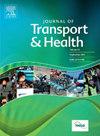Assessing on-road cyclist behavior: A pilot evaluation of the cyclist behavior questionnaire for U.S. riders
IF 3.3
3区 工程技术
Q2 PUBLIC, ENVIRONMENTAL & OCCUPATIONAL HEALTH
引用次数: 0
Abstract
Introduction
Cycling is an affordable and environmentally sustainable mode of transportation that promotes physical activity. However, the rising cyclist-motor vehicle crashes in the U.S. highlights the need to understand behavioral factors associated with cyclist crashes. This study aimed to develop and evaluate a Cyclist Behavior Questionnaire (CBQ-US) for the U.S. riders.
Methods
This study employed a mixed-method validation by combining a self-reported survey (N = 224) with a scenario-based bike simulator study. The psychometric structure was examined using Principal Component Analysis (PCA) and Confirmatory Factor Analysis (CFA). Predictive validity was tested in a bike simulator using ordinal logistic regression, and ANOVA was used to reveal demographic differences.
Results
PCA identified a four-factor model (violation, aggressive violation, positive behavior, and distraction and forgetfulness), that explained 66.9 % of the variance. CFA confirmed the structure with adequate model fit. Simulator-based scenarios significantly predicted the CBQ-US subscales. Demographic analyses demonstrated that male cyclists exhibited higher rates of aggressive violations. Middle-aged cyclists and those with a history of crashes with non-motor vehicles reported more distraction and forgetfulness. Notable differences were also observed across states, indicating the influence of inconsistent infrastructure and traffic laws.
Conclusion
The CBQ-US demonstrated strong psychometric properties, and the findings support the need for targeted interventions, such as restricting phone use, promoting bone-conductive headphones, infrastructure improvements and educational campaigns, to reduce crash risks. Despite having some limitations, the CBQ-US can be used as a useful tool in behavioral research and policy developments to promote cyclist safety and encourage active travel.
评估在道路上骑自行车的行为:美国骑自行车者的行为问卷的试点评估
自行车是一种负担得起的环保可持续的交通方式,可以促进身体活动。然而,美国不断增加的骑自行车者与机动车相撞事故凸显了了解与骑自行车者相撞有关的行为因素的必要性。本研究的目的是开发和评估美国自行车手行为问卷(CBQ-US)。方法采用自我报告调查(N = 224)和基于场景的自行车模拟器研究相结合的混合方法进行验证。采用主成分分析(PCA)和验证性因子分析(CFA)对心理测量结构进行检验。在自行车模拟器中使用有序逻辑回归测试预测效度,并使用方差分析来揭示人口统计学差异。结果spca确定了一个四因素模型(违章行为、攻击性违章行为、积极行为、注意力分散和健忘),解释了66.9%的方差。CFA证实结构具有足够的模型拟合。基于模拟器的情景显著预测CBQ-US分量表。人口统计分析表明,骑自行车的男性表现出更高的攻击性违规率。中年骑自行车者和有非机动车撞车史的人更容易分心和健忘。各州之间也存在显著差异,这表明基础设施和交通法规不一致的影响。结论:CBQ-US显示出强大的心理测量特性,研究结果支持有针对性的干预措施的必要性,如限制使用手机,推广骨传导耳机,改善基础设施和教育活动,以减少碰撞风险。尽管CBQ-US有一些局限性,但它可以作为行为研究和政策制定的有用工具,以促进骑自行车者的安全,鼓励积极出行。
本文章由计算机程序翻译,如有差异,请以英文原文为准。
求助全文
约1分钟内获得全文
求助全文

 求助内容:
求助内容: 应助结果提醒方式:
应助结果提醒方式:


